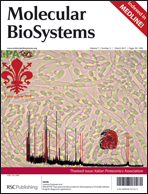RAF kinase inhibitory protein (RKIP) modulates cell cycle kinetics and motility†
Abstract
RKIP-1 is a metastasis suppressor that is frequently downregulated in aggressive cancers. However, the consequences of RKIP loss in primary or immortalized cells have not yet been explored. Using HEK-293 RKIP depleted (termed HEK-499) and Flp-In T-Rex-293 RKIP inducible cell lines combined with whole transcriptome analysis, we show that RKIP-1 silencing accelerates DNA synthesis and G1/S transition entry by inducing the expression of cdc6, MCM 2, 4, 6, 7, cdc45L, cyclin D2, cyclin E2, cyclin D1, SKP2 and the downregulation of p21cip1. Moreover, RKIP depletion accelerates the time from nuclear envelop breakdown (NEB) to anaphase markedly, while the upregulation of RKIP shortened the NEB to anaphase time. We show that RKIP depletion induces the expression of NEK6, a molecule known to enhance G2/M transition, and down-regulates G2/M checkpoint molecules like Aurora B, cyclin G1 and sertuin that slow the G2/M transition time. These subtle changes in the kinetics of the cell cycle culminate in a higher proliferation rate of HEK-499 compared to control cells. Finally, we show that RKIP depletion enhances cellular motility by inducing the expression/stabilization of β-catenin, vimentin,


 Please wait while we load your content...
Please wait while we load your content...